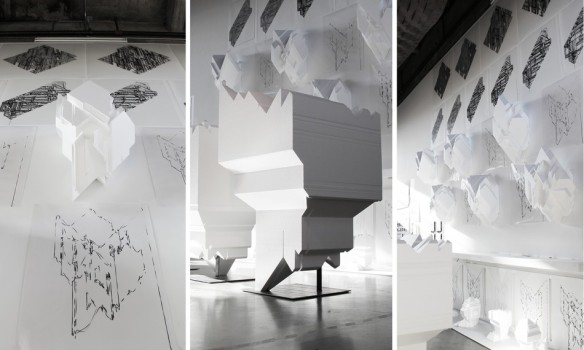Low Fidelity by Erin Besler is a thesis that steps outside the generic fromula of approaching thesis; which normally is problem, solution, building. The thesis challenges the mediums in which architecture and building are understood. She goes far beyond any case study in her explorational thesis which is married with House VI by Peter Eisenman. Each time flipping the design on its head and challenging it in a new medium and way of understanding architect through graphic and physical mediums. Check it out after the jump!
STUDENT: Erin Besler
SCHOOL: SCI-ARC
PROFESSORS: Andrew Atwood
COURSE: Thesis
YEAR: 2012
Low Fidelity – Thesis Presentation Video from Erin Besler on Vimeo.
“The ascent of high fidelity reproduction has collapsed the gap between disciplinary mediums. The productive tensions and generative discrepancies that occur through mediums of architectural representation have been obliterated. The gap is essential, identified by Robin Evans in his essay Translations From Drawing to Building as “the blind spot between the drawing and its object” (1). The gap is what has allowed for generative friction in the process of architectural design. It is what has defined architecture as a discipline of mediation and has provided room for creative space within the specificities of architecture’s transitive mediums. Low Fidelity proposes to reestablish the gap; not by returning to old models, but by inverting those models, flipping them on their heads, and shaking out architecture’s characteristic methods (2) along with those mediums absorbed by the collapse.
Low Fidelity pushes through the homogenous high fidelity verisimilitude, beginning with the architectural object, moving through translation and abstraction to its representation, the drawing, as both generator and generated. While the drawing continues to be the two dimensional architectural communicant (3), the intervening medium (4) with the ability to flatten and abstract, to distance itself from the object, and produce friction between objects and their mutual representations, this thesis goes further. The drawing’s agency is extended through alternative mediums of translation to subvert the homogeneity of digital tools and take advantage of the seductive latency of representation (5) .
Projection, architecture’s transitive and transformative medium, with its propensity to abstract and reduce, subjectively extends the drawing to provoke rupture in the immediacy of the relationship between architectural representations and incite instability. Where some might contend the discrepant as unlawful, the methodology that this thesis argues for engages the infidelities that challenge and interrupt our interface with matters of materialization. Through the registration of projected points in space, the reduction and delineation of a single curve and the materialization of the drawn form through mechanically attenuated extrusion, Low Fidelity activates tension between architectural mediums and alienates objects of representation to locate alternative sites for design.”
– Erin Besler
Check out the rest of Erin Besler work and thesis at www.erinbesler.com
(1) Robin Evans, Translations from Drawing to Building in Translations From Drawing to Building and Other Essays (1997), 182.
(2) Clement Greenberg, Modernist Painting (1960).
(3) Evans, 155.
(4) Evans, 156.
(5) Alberto Perez Gomez and Louise Pelletier, Architectural Representation and the Perspective Hinge
All text and video via www.erinbesler.com/






![15_TRANSFORMATION TOOLPATHS [Converted]-01a](http://futuresplus.files.wordpress.com/2012/09/15_transformation-toolpaths-converted-01a.png?w=584&h=231)